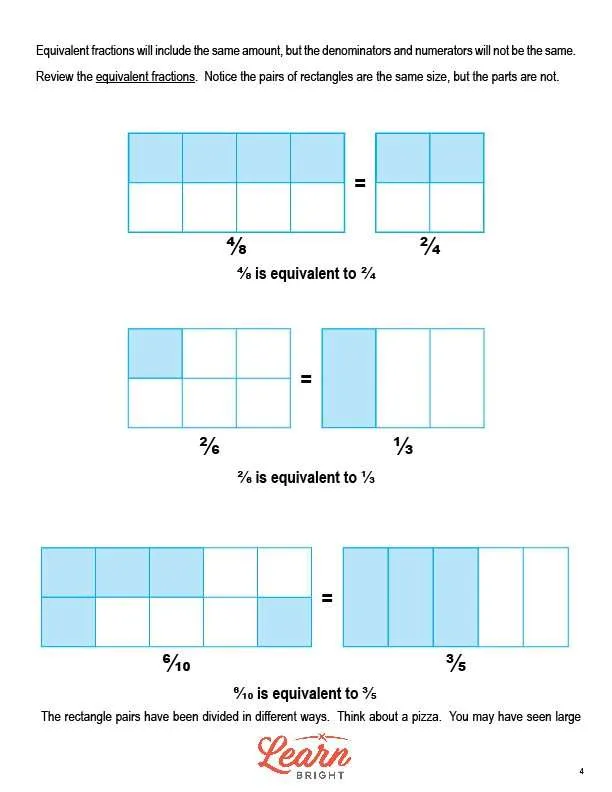Description
What our Introduction to Equivalent Fractions lesson plan includes
Lesson Objectives and Overview: Introduction to Equivalent Fractions teaches students all about equivalent fractions, including how to recognize and define them. At the end of the lesson, students will be able to explain and define the concept of equivalent fractions. This lesson is for students in 3rd grade.
Classroom Procedure
Every lesson plan provides you with a classroom procedure page that outlines a step-by-step guide to follow. You do not have to follow the guide exactly. The guide helps you organize the lesson and details when to hand out worksheets. It also lists information in the blue box that you might find useful. You will find the lesson objectives, state standards, and number of class sessions the lesson should take to complete in this area. In addition, it describes the supplies you will need as well as what and how you need to prepare beforehand.
Options for Lesson
Included with this lesson is an “Options for Lesson” section that lists a number of suggestions for activities to add to the lesson or substitutions for the ones already in the lesson. One optional adjustment to the lesson activity is to have your students cut apart the activity circles and paste them to a poster showing equivalent fraction models. You can also have your students create from-scratch equivalent fraction models made from various manipulatives. Finally, to add to the lesson, you could conduct a class discussion on the use of equivalent fractions and why they are necessary.
Teacher Notes
The teacher notes page includes a paragraph with additional guidelines and things to think about as you begin to plan your lesson. This page also includes lines that you can use to add your own notes as you’re preparing for this lesson.
INTRODUCTION TO EQUIVALENT FRACTIONS LESSON PLAN CONTENT PAGES
Meaning of Equivalent
The Introduction to Equivalent Fractions lesson plan includes three content pages. The word equal means the same number or amount. 7 is equal to 7. 7 is also equal to 5 + 2, 4 + 3, and 6 + 1. We also use the equal sign (=) in math. The word equivalent has almost the exact same meaning as the word equal. Equivalent means equal in value or amount.
In math, we have a concept called equivalent fractions. However, in this case, the word equivalent does not necessarily mean that two fractions have the same value.
Introduction to Equivalent Fractions
If you’ve ever drunk half a glass of water and half a glass of soda at the same time, but they were in the different sized cups, you might have different amounts of the two liquids left over. Half of a small cup and half of a large cup are different amounts, but the fractions we use for them are the same, or equivalent. 1/2 and 1/2 are equivalent. If the cups were the same size, the amounts would be equivalent too!
Equivalent fractions depend on the size or value of the whole. The top number of the fraction (the numerator) tells you the part of the whole, while the bottom number (the denominator) tells you the whole. In the example with the liquids, one of two parts of each glass is liquid while one of two parts of each glass is empty.
Some equivalent fractions include the same amount, but with different numerators and denominators. The lesson lists some equivalent fractions with helpful pictures. 4/8 is equivalent to 2/4, 2/6 is equivalent to 1/3, and 6/10 is equivalent to 3/5. If you look at the pictures, you can see that the amounts are different, even though the fractions are equivalent.
Sometimes, equivalent fractions do represent the same amounts. For example, say you had two pizzas, one cut into four pieces and the other cut into 8 pieces. The size of the pieces are different, but the whole pizzas are the same size. For these pizzas, 3/4 of the first pizza is the same as 6/8 of the second pizza. Eating three pieces of the first pizza is the same as eating six pieces of the second. In this case, the fractions are equivalent and the amounts are equal.
Remember that equivalent fractions have the same value and amount. They are equal when the wholes are the same. Pay attention next time you’re at a pizza party and you might see equivalent fractions at work!
INTRODUCTION TO EQUIVALENT FRACTIONS LESSON PLAN WORKSHEETS
The Introduction to Equivalent Fractions lesson plan includes three worksheets: an activity worksheet, a practice worksheet, and a homework assignment. You can refer to the guide on the classroom procedure page to determine when to hand out each worksheet.
PAPER PLATES ACTIVITY WORKSHEET
Students will work with a partner to complete the activity worksheet. Each pair will use paper plates and colored pencils or markers to create models of equivalent fractions. For each pair of equivalent fractions, they will show their models using the circles printed on the worksheet.
EQUIVALENT FRACTION MATCHING PRACTICE WORKSHEET
The practice worksheet asks students to match the equivalent shaded fraction pictures shown on the worksheet. They will also write the fraction next to each picture.
INTRODUCTION TO EQUIVALENT FRACTIONS HOMEWORK ASSIGNMENT
For the homework assignment, students will first fill in the blanks on the worksheet using the word bank. Next, they will tell whether four statements related to equivalent fractions are true or false. Finally, they will create models for the given equivalent fractions.
Worksheet Answer Keys
This lesson plan includes answer keys for the practice worksheet and the homework assignment. If you choose to administer the lesson pages to your students via PDF, you will need to save a new file that omits these pages. Otherwise, you can simply print out the applicable pages and keep these as reference for yourself when grading assignments.









